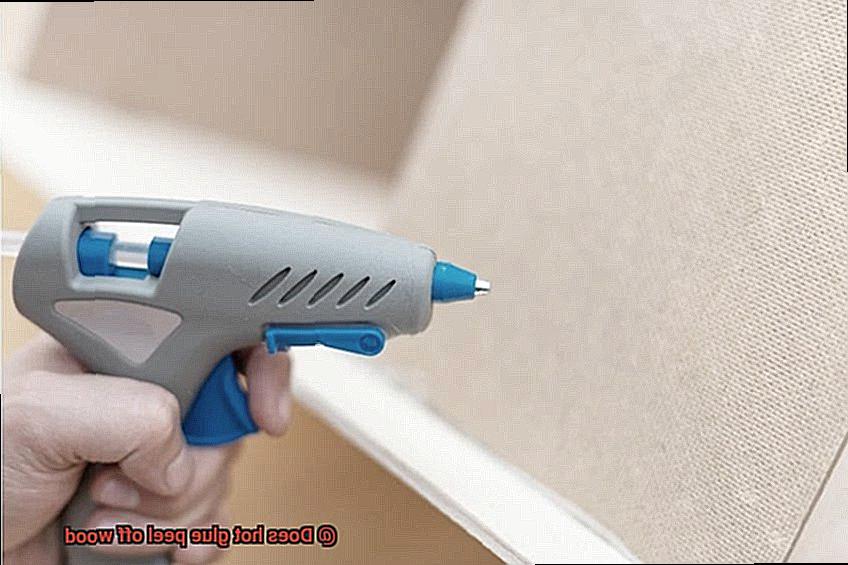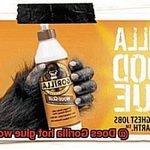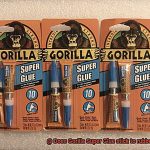If you’re anything like me, you probably can’t get enough of hot glue and all the amazing things it can do. But here’s the burning question: does hot glue really play nice with wood?
And what happens when you try to peel it off? Well, today we’re going on a wild ride through the fascinating world of hot glue and its relationship with wood.
So, grab your trusty glue gun and let’s get down to business.
Adhesion of Hot Glue to Wood
Contents
- 1 Adhesion of Hot Glue to Wood
- 2 Factors Affecting the Bond Between Hot Glue and Wood
- 3 Types of Wood and Their Impact on Adhesion
- 4 Protective Coatings and their Effect on Adhesion
- 5 Temperature Considerations for Applying Hot Glue to Wood
- 6 Removing Hot Glue from Wood
- 7 Heat Application for Easier Removal
- 8 Conclusion
In this article, we will delve into the fascinating factors that influence the adhesion of hot glue to wood, exploring the type of wood, temperature, and surface preparation that play crucial roles.
The Type of Wood:
Hot glue forms a strong bond with porous and absorbent woods like pine, cedar, and plywood. These woods boast open grain structures that allow the hot glue to penetrate the surface, creating an unyielding grip. Conversely, smooth and dense woods such as oak or maple may not provide enough traction for the adhesive, resulting in weaker adhesion. Selecting the right type of wood is essential for a robust bond.
Temperature:
The application temperature is a critical factor in optimizing adhesion.
Hot glue must be applied at a high temperature to ensure easy melting and flow. However, excessively high temperatures can scorch or burn the wood surface, jeopardizing the bond.
Striking the perfect balance between temperature and viscosity is key to achieving flawless adhesion without compromising the integrity of the wood.
Surface Preparation:
Preparing the wood surface properly lays the foundation for a strong bond between hot glue and wood. Prior to application, ensure that the surface is free from any dirt or debris that could hinder adhesion.
A light sanding of the surface provides a rougher texture, allowing the hot glue to establish a firmer grip. Applying a primer or sealant further enhances adhesion by promoting better interaction between the hot glue and wood.
Factors Affecting the Bond Between Hot Glue and Wood
The bond between hot glue and wood can make or break your DIY projects. To ensure a strong and lasting bond, it’s important to consider several factors.
Firstly, temperature plays a crucial role. Hot glue needs to be heated to a specific temperature range of 380 to 410 degrees Fahrenheit (193 to 210 degrees Celsius) for optimal melting and bonding. If the temperature is too low, the glue won’t fully melt, resulting in a weak bond. Conversely, if the temperature is too high, the wood may scorch or burn, weakening the bond or damaging the surface. Finding the right temperature is essential for success.
Next, proper surface preparation is key. The wood surface must be clean, dry, and free from any dust, dirt, or grease. Sanding the surface creates a rough texture that provides more surface area for the glue to grip onto. Some woods may have natural oils or finishes that hinder adhesion, so removing these or using a primer designed for hot glue bonding is necessary.
The type of wood being used also affects the bond. Porous woods with open grains like pine or cedar tend to have better adhesive properties than dense hardwoods like oak or maple. The pores allow the hot glue to penetrate and form a stronger bond within the wood fibers. However, each wood species can vary in its adhesive properties, so testing the bond strength on a small area is always wise.
Choosing the right glue formulation is crucial as well. Hot glue comes in different formulations tailored for specific applications. When bonding wood, it’s essential to choose a formulation compatible with wood and offering good adhesion properties. Some hot glues made specifically for wood bonding may contain additives that enhance bond strength or improve flexibility.
Lastly, consider the stress and load on the joint. While hot glue provides a strong bond, it’s not as durable or resistant to heavy loads as other adhesives like epoxy or wood glue. If your project will bear weight or experience significant stress, using a stronger adhesive may be necessary.
Types of Wood and Their Impact on Adhesion
Hot glue is a versatile adhesive that is widely used in crafting and DIY projects. However, not all woods are created equal when it comes to their compatibility with hot glue. In this article, we will explore how different types of wood can impact the adhesion of hot glue.
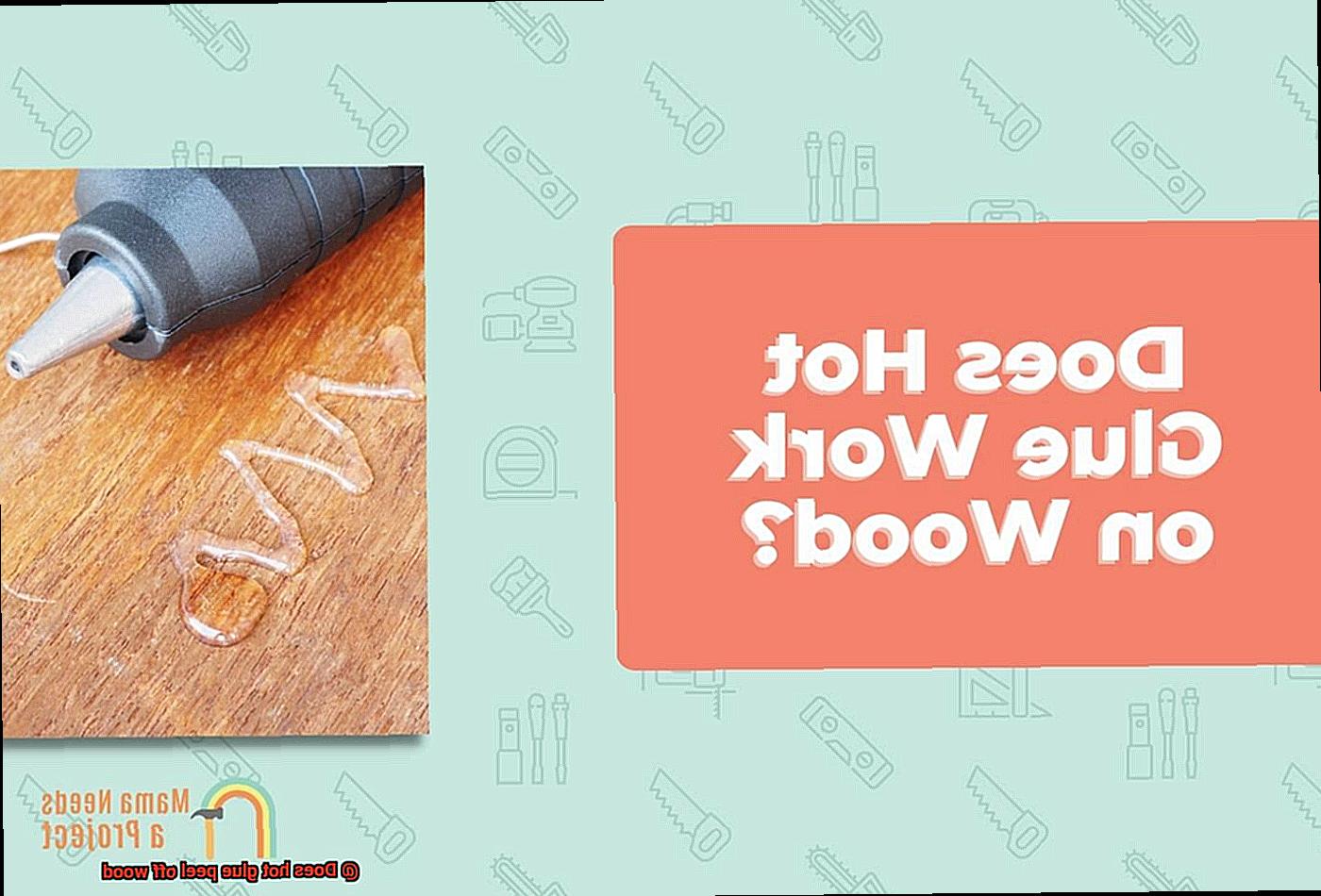
By understanding the unique properties of each wood type, you can make informed decisions to ensure strong and long-lasting bonds in your projects.
Softwoods – The Porous Allies
Softwoods, such as pine or cedar, are known for their porous nature. These woods have open pores that allow the hot glue to penetrate deep into the fibers, creating a strong bond. When hot glue is applied to softwoods, it seeps into the pores, creating an intimate connection between the glue and the wood. This results in a reliable adhesion that withstands the test of time and usage.
Hardwoods – The Tough Nuts to Crack
Unlike softwoods, hardwoods like oak or mahogany have a denser structure with tighter grain patterns. This density makes it more challenging for hot glue to penetrate and form a strong bond. However, some hardwoods with open grain structures, such as ash or walnut, can still provide good adhesion for hot glue.
To improve adhesion with hardwoods, it is recommended to roughen up the surface using sandpaper before applying hot glue. By creating small indentations and micro-abrasions on the wood surface, you provide more surface area for the hot glue to grip onto, enhancing its adhesion.
Engineered Wood – A Smooth Operator
Engineered woods like plywood or particleboard are made by bonding layers of wood veneers or particles together. These woods tend to have smoother surfaces compared to solid wood, which can affect the adhesion of hot glue.
The smoothness of the surface can make it more challenging for the hot glue to grip onto the wood. To improve adhesion with engineered wood, it is recommended to sand the surface before applying hot glue. Sanding creates a slightly rougher texture, allowing the hot glue to adhere more effectively.
Treated Wood – A Barrier to Adhesion
Treated wood refers to wood that has been treated with chemicals for added durability and resistance to decay. While these treatments are beneficial for protecting the wood, they can create a barrier between the hot glue and wood surface.
This barrier can weaken the bond between the two, resulting in weaker adhesion. If you’re working with treated wood, consider roughening up the surface using sandpaper or applying a primer specifically designed for treated wood before applying hot glue. These steps will help create a more suitable surface for the hot glue to adhere to.
Exotic Woods – Beauty and Adhesion
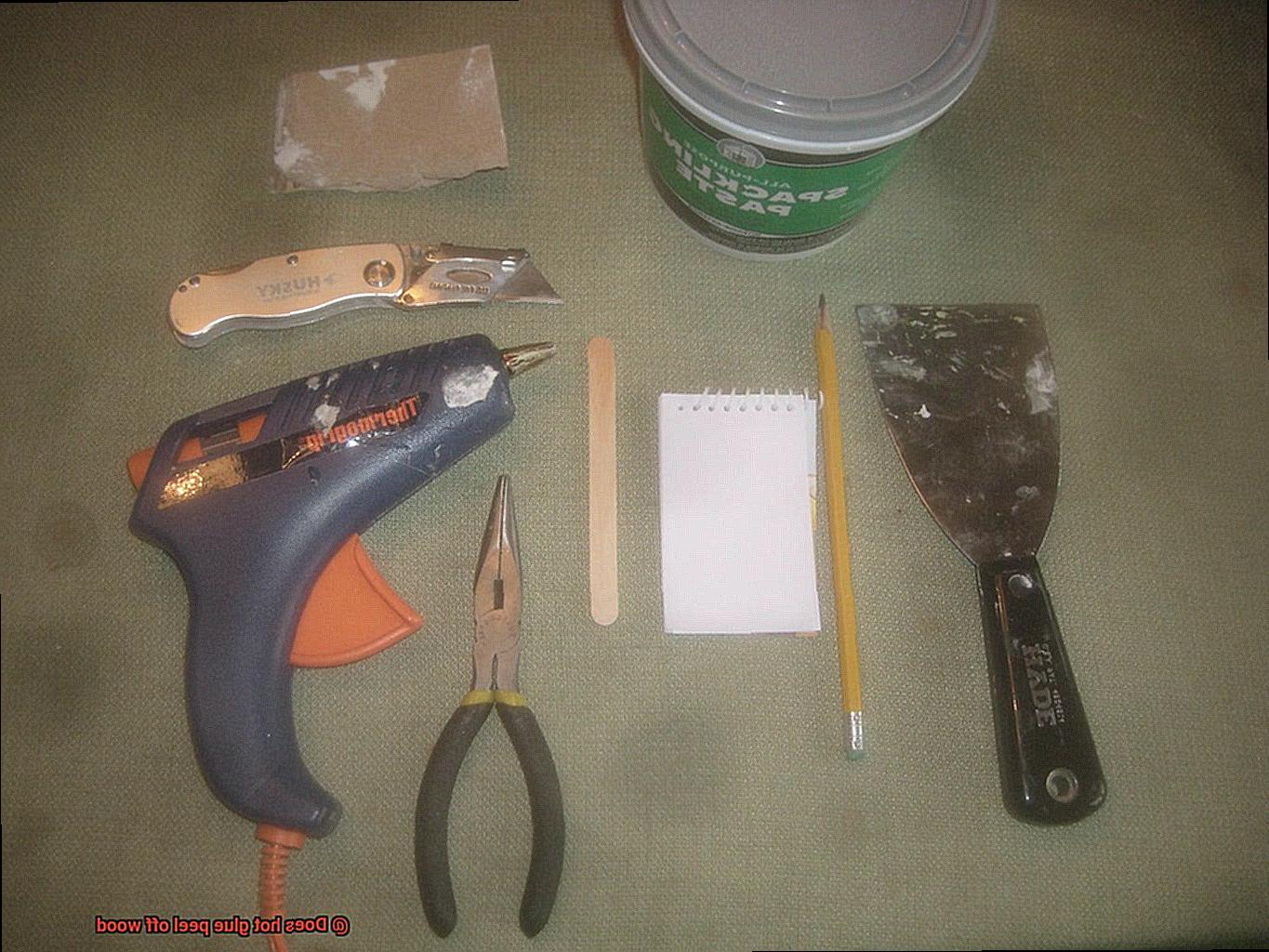
Exotic woods like teak or rosewood are prized for their unique grain patterns and rich colors. However, their adhesion properties can vary depending on their density and surface characteristics. Some exotic woods may require special surface preparation, such as sanding or cleaning, to ensure proper adhesion of hot glue. By taking the time to prepare the surface before applying hot glue, you can ensure a strong bond that showcases the beauty of these exotic woods.
Protective Coatings and their Effect on Adhesion
Protective coatings play a crucial role in the adhesion of hot glue to wood surfaces. The type of protective coating you choose can determine whether your project stays intact or falls apart. Let’s dive deeper into the world of protective coatings and explore their effect on adhesion.
First up is varnish, a clear and glossy coating that not only adds a beautiful finish to your wood surfaces but also creates a smooth surface for hot glue to adhere to. Say goodbye to peeling. Varnish forms a hard, durable film that provides an ideal surface for hot glue adhesion.
Next on our list is lacquer. Just like varnish, lacquer dries quickly and forms a hard, durable finish. It enhances the adhesion of hot glue by providing a smooth surface for it to grip onto. This ensures that your project stays securely intact.
If durability is your top priority, then polyurethane is the go-to coating for you. Available in water-based or oil-based formulas, polyurethane offers excellent resistance to wear and tear. It creates a strong bond between hot glue and wood, ensuring your project stays intact even under heavy use.
Last but certainly not least is epoxy. This versatile adhesive doubles as a protective coating and forms an incredibly strong bond with wood surfaces. Whether you’re working on a small craft project or tackling a larger woodworking endeavor, epoxy will ensure that your hot glue sticks like a champ.
However, not all protective coatings are created equal when it comes to adhesion. Be cautious of wax or silicone-based products as they can create a barrier that prevents hot glue from adhering properly. So make sure to remove or avoid these coatings if you want that strong bond.
Remember, the key to successful adhesion is not only the type of protective coating but also proper surface preparation. Clean and dry your wood surface before applying hot glue for the best results. This will ensure optimal adhesion and reduce the risk of peeling.
Temperature Considerations for Applying Hot Glue to Wood
When it comes to bonding wood with hot glue, temperature considerations are essential for success. Hot glue is a versatile adhesive that is commonly used in crafting and DIY projects. However, applying it at the right temperature is crucial to ensure a strong and durable bond.
Let’s start with the glue gun. This handy tool is what heats up the glue stick and turns it into a liquid form. Typically operating at around 350°F (175°C), the high temperature allows the glue to flow easily and create a powerful bond once it solidifies.
Now, why does temperature matter? Well, when applying hot glue to wood, you want to make sure that the surface is clean and free from any dust or debris. This maximizes the bonding strength of the glue. Additionally, preheating the wood before applying the glue can make a significant difference. By using a heat gun or simply placing the wood in a warm environment for a few minutes, you open up the pores of the wood, allowing the hot glue to penetrate and bond more effectively.
Different types of wood may require different optimal temperatures for hot glue application. Hardwoods like oak or maple may need higher temperatures compared to softwoods like pine or cedar. It’s always a good idea to check the manufacturer’s recommendations for your specific hot glue gun.
However, be cautious not to apply excessive heat. High temperatures can cause certain types of wood, especially those with high moisture content, to warp or deform. To avoid any mishaps, it’s best to test a small amount of glue on a scrap piece of wood before diving into your project.
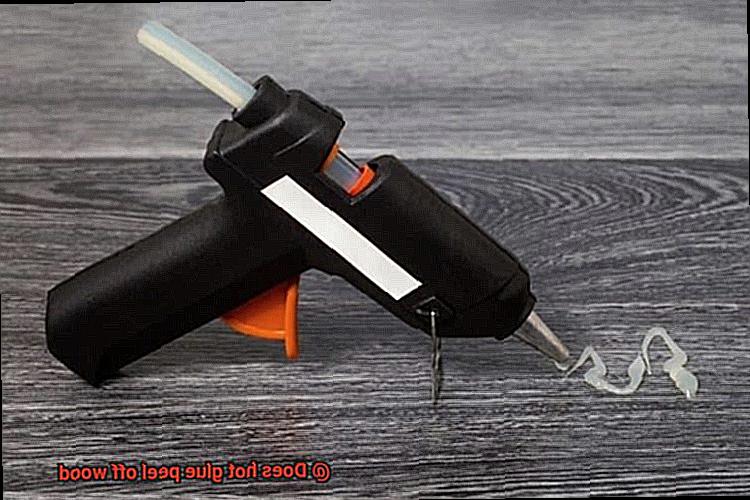
Removing Hot Glue from Wood
Hot glue is a versatile adhesive that’s perfect for all your DIY projects. But what happens when that sticky situation turns into a sticky mess on your beautiful wooden surface? Fear not. We’ve got you covered with some tried-and-true methods to remove hot glue from wood. Whether you’re a craft enthusiast or just had an unfortunate mishap, keep reading to discover the secrets of glue removal.
Method 1: Heat it up.
When dealing with fresh hot glue, harnessing the power of heat can be your best bet for removal. Grab your trusty hairdryer or heat gun and apply gentle heat to soften the glue. Take caution and use short bursts of heat to avoid damaging the wood. Once pliable, delicately scrape off the glue using a plastic scraper or even an old credit card.
Method 2: Solvent power.
For stubborn hot glue, solvents such as rubbing alcohol or acetone can come to your rescue. Before applying any solvents, test them on a hidden area of the wood to ensure they won’t cause damage. Moisten a cloth or sponge with the solvent and gently rub it onto the glue until it begins to loosen. Use a plastic scraper or clean cloth to remove the softened glue.
Method 3: Hardened glue? No worries.
If the hot glue has dried and hardened on the wood, it’s time to bring out the sandpaper. Carefully sand away the glue, starting with a gentle touch and gradually increasing pressure if needed. Take care not to damage the wood surface while removing the hardened glue.
Method 4: A little extra help from adhesive removers:
For those persistent hot glue stains, adhesive removers can be your secret weapon. Follow the manufacturer’s instructions carefully and take necessary safety precautions. Apply the adhesive remover to a cloth or sponge and gently rub it onto the glue until it softens. Use a plastic scraper or wipe away the softened glue with a clean cloth.
Finishing touches:
Even after removing the glue, residue may remain on the wood surface. To banish any lingering stickiness, create a mild soap and water solution. Thoroughly wipe down the wood with the soapy water, ensuring all residue is removed, and then dry it completely.
Heat Application for Easier Removal
Are you tired of struggling with stubborn hot glue on wood surfaces? Well, fear not, because I have a nifty trick that will make your life a whole lot easier: heat application. By harnessing the power of heat, you can effortlessly soften and remove that annoying hot glue without causing any damage to your precious wood.
Using a heat gun for bigger jobs
Using a hairdryer or heat gun is one handy method for removing hot glue. Simply direct the hot air onto the glued area, melting the glue and loosening its grip on the wood. Start with the lowest heat setting to avoid mishaps, gradually increasing if needed. We want to save the wood, not scorch it.
Another effective tool is a clothes iron. Place a cloth or parchment paper over the glue and set the iron to a low heat setting. Gently press it on top, allowing the heat to transfer through and soften the glue. Then, peel it off with a plastic scraper or your fingers. It’s like magic.
For bigger jobs or thicker layers of hot glue, a heat gun may be your best bet. Aim the heat gun at the glued area while moving it back and forth. The gradual application of heat will melt the glue, making it easy to scrape off with a plastic scraper or your fingers. Keep a safe distance from the wood to prevent accidental damage.
Remember that not all glues are created equal, so test the method on a small area first. Excessive heat or prolonged exposure can potentially damage certain types of wood or finishes.
Also Read: What is the best glue to stick fabric to wood?
Conclusion
In conclusion, the adhesion of hot glue to wood depends on several crucial factors. The type of wood, temperature, and surface preparation all play pivotal roles in determining the strength of the bond.
Certain woods, like pine, cedar, and plywood, are porous and absorbent, providing an ideal surface for hot glue to penetrate deeply and establish a strong grip. On the other hand, smooth and dense woods such as oak or maple may not offer enough traction for the adhesive, resulting in weaker adhesion.
Temperature is a critical consideration when working with hot glue. To ensure optimal melting and flow, it must be applied at a high temperature. However, caution must be exercised to avoid excessively high temperatures that can scorch or burn the wood surface, compromising the bond. Striking the perfect balance between temperature and viscosity is key to achieving a successful bond.
Proper surface preparation is paramount for a strong bond between hot glue and wood. The wood surface should be meticulously cleaned and free from any dirt or debris that could hinder adhesion. By sanding the surface, you create a rougher texture that allows the hot glue to establish an even firmer grip. Applying a primer or sealant further enhances adhesion by promoting better interaction between the hot glue and wood.
The presence of protective coatings on wood surfaces can also impact adhesion. Varnish, lacquer, polyurethane, or epoxy provide smooth surfaces for hot glue to adhere to securely. However, it’s best to steer clear of wax or silicone-based products as they can create barriers that prevent proper adhesion.
When it comes time to remove hot glue from wood surfaces without causing damage, heat application proves effective. Utilizing tools such as a hairdryer, heat gun, or clothes iron can soften the glue and make it easier to remove while preserving the integrity of the wood.
By understanding these crucial factors and taking appropriate measures in your DIY projects involving hot glue and wood, you can confidently unleash your creativity and achieve successful bonding.

